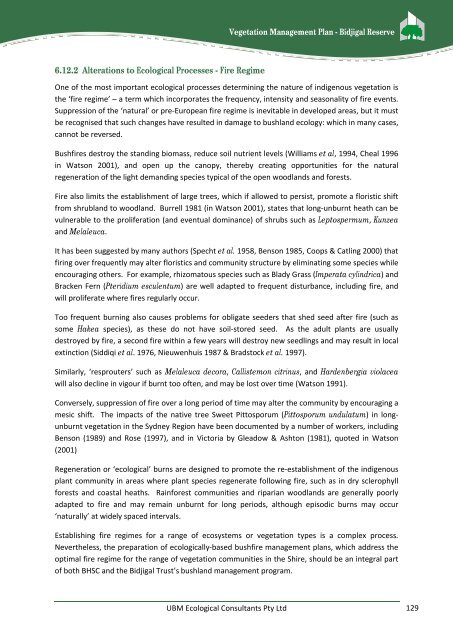VEGETATION MANAGEMENT PLAN for Bidjigal Reserve - Land
VEGETATION MANAGEMENT PLAN for Bidjigal Reserve - Land
VEGETATION MANAGEMENT PLAN for Bidjigal Reserve - Land
You also want an ePaper? Increase the reach of your titles
YUMPU automatically turns print PDFs into web optimized ePapers that Google loves.
Vegetation Management Plan - <strong>Bidjigal</strong> <strong>Reserve</strong>6.12.2 Alterations to Ecological Processes - Fire RegimeOne of the most important ecological processes determining the nature of indigenous vegetation isthe ‘fire regime’ – a term which incorporates the frequency, intensity and seasonality of fire events.Suppression of the ‘natural’ or pre-European fire regime is inevitable in developed areas, but it mustbe recognised that such changes have resulted in damage to bushland ecology: which in many cases,cannot be reversed.Bushfires destroy the standing biomass, reduce soil nutrient levels (Williams et al, 1994, Cheal 1996in Watson 2001), and open up the canopy, thereby creating opportunities <strong>for</strong> the naturalregeneration of the light demanding species typical of the open woodlands and <strong>for</strong>ests.Fire also limits the establishment of large trees, which if allowed to persist, promote a floristic shiftfrom shrubland to woodland. Burrell 1981 (in Watson 2001), states that long-unburnt heath can bevulnerable to the proliferation (and eventual dominance) of shrubs such as Leptospermum, Kunzeaand Melaleuca.It has been suggested by many authors (Specht et al. 1958, Benson 1985, Coops & Catling 2000) thatfiring over frequently may alter floristics and community structure by eliminating some species whileencouraging others. For example, rhizomatous species such as Blady Grass (Imperata cylindrica) andBracken Fern (Pteridium esculentum) are well adapted to frequent disturbance, including fire, andwill proliferate where fires regularly occur.Too frequent burning also causes problems <strong>for</strong> obligate seeders that shed seed after fire (such assome Hakea species), as these do not have soil-stored seed. As the adult plants are usuallydestroyed by fire, a second fire within a few years will destroy new seedlings and may result in localextinction (Siddiqi et al. 1976, Nieuwenhuis 1987 & Bradstock et al. 1997).Similarly, ‘resprouters’ such as Melaleuca decora, Callistemon citrinus, and Hardenbergia violaceawill also decline in vigour if burnt too often, and may be lost over time (Watson 1991).Conversely, suppression of fire over a long period of time may alter the community by encouraging amesic shift. The impacts of the native tree Sweet Pittosporum (Pittosporum undulatum) in longunburntvegetation in the Sydney Region have been documented by a number of workers, includingBenson (1989) and Rose (1997), and in Victoria by Gleadow & Ashton (1981), quoted in Watson(2001)Regeneration or ‘ecological’ burns are designed to promote the re-establishment of the indigenousplant community in areas where plant species regenerate following fire, such as in dry sclerophyll<strong>for</strong>ests and coastal heaths. Rain<strong>for</strong>est communities and riparian woodlands are generally poorlyadapted to fire and may remain unburnt <strong>for</strong> long periods, although episodic burns may occur‘naturally’ at widely spaced intervals.Establishing fire regimes <strong>for</strong> a range of ecosystems or vegetation types is a complex process.Nevertheless, the preparation of ecologically-based bushfire management plans, which address theoptimal fire regime <strong>for</strong> the range of vegetation communities in the Shire, should be an integral partof both BHSC and the <strong>Bidjigal</strong> Trust’s bushland management program.UBM Ecological Consultants Pty Ltd 129
















